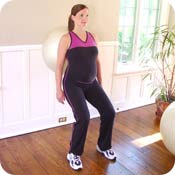
Before you begin or continue an exercise program during pregnancy, it is mandatory that you discuss your fitness plan with your medical provider. Continue to obtain approval from your healthcare professional for continued exercise during each prenatal appointment.
Absolute Contraindications to Exercise Conditions that indicate a woman should not participate in an exercise program during pregnancy. (ACOG Guidelines)
Warning Signs to Stop Exercise Stop exercise immediately and contact your healthcare provider if you experience any of the following during or after exercise: (ACOG Guidelines)
Exercise Intensity during Pregnancy The exercises you can do during pregnancy depend on two things: your current health and how active you were before you became pregnant. Experts suggest using the Rate of Perceived Exertion (RPE) Scale, also called the Modified Borg Scale. The version of the Borg scale that BabyFit uses ranges from 1 to 10, and is a self-assessment. When pregnant, you should exercise between level 4 (somewhat hard) and level 6 (hard). Do not overdo it. You don't want to become breathless or exhausted. In the proper range, you should be able to carry on a conversation with someone next to you. If you can sing, you may not be exercising intensely enough, but if you are too winded to speak, then slow down. Discuss your exercise intensity and get a recommendation from you healthcare provider beforehand. Here is a full explanation of the Rate of Perceived Exertion scale. Continued › |
Exercise During Pregnancy: Keeping It Safe
Required Exercise Guidelines for Our Members
Page 1 of 2 Next Page ›





Member Comments